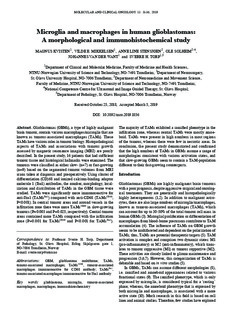| dc.contributor.author | Kvisten, Magnus | |
| dc.contributor.author | Mikkelsen, Vilde Elisabeth | |
| dc.contributor.author | Stensjøen, Anne Line | |
| dc.contributor.author | Solheim, Ole | |
| dc.contributor.author | van der Want, Johannes Jacobus Leendert | |
| dc.contributor.author | Torp, Sverre Helge | |
| dc.date.accessioned | 2020-02-11T11:47:04Z | |
| dc.date.available | 2020-02-11T11:47:04Z | |
| dc.date.created | 2019-05-21T08:17:43Z | |
| dc.date.issued | 2019 | |
| dc.identifier.citation | Molecular and clinical oncology. 2019, 11 (1), 31-36. | nb_NO |
| dc.identifier.issn | 2049-9450 | |
| dc.identifier.uri | http://hdl.handle.net/11250/2641014 | |
| dc.description.abstract | Glioblastomas (GBMs), a type of highly malignant brain tumour, contain various macrophages/microglia that are known as tumour‑associated macrophages (TAMs). These TAMs have various roles in tumour biology. Histopathological aspects of TAMs and associations with tumour growth assessed by magnetic resonance imaging (MRI) are poorly described. In the present study, 16 patients that had sufficient tumour tissue and histological hallmarks were examined. The tumours were classified as either slow‑ (n=7) or fast‑growing (n=9) based on the segmented tumour volumes from MRI scans taken at diagnosis and preoperatively. Using cluster of differentiation (CD)68 and ionized calcium-binding adaptor molecule 1 (Iba1) antibodies, the number, morphology, localization and distribution of TAMs in the GBM tissue were studied. TAMs were significantly more immunoreactive for anti‑Iba1 (TAMsIba1) compared with anti‑CD68 (TAMsCD68; P<0.001). In central tumour areas and around vessels in the infiltration zone there were more TAMsCD68 in slow‑growing tumours (P=0.003 and P=0.025, respectively). Central tumour areas contained more TAMs compared with the infiltration zone (P=0.001 for TAMsCD68 and P<0.001 for TAMsIba1). The majority of TAMs exhibited a ramified phenotype in the infiltration zone, whereas central TAMs were mostly amoeboid. TAMs were present in high numbers in most regions of the tumour, whereas there were few in necrotic areas. In conclusion, the present study demonstrated and confirmed that the high numbers of TAMs in GBMs assume a range of morphologies consistent with various activation states, and that slow‑growing GBMs seem to contain a TAM‑population different to their fast‑growing counterparts. | nb_NO |
| dc.language.iso | eng | nb_NO |
| dc.publisher | Spandidos Publications | nb_NO |
| dc.rights | Navngivelse 4.0 Internasjonal | * |
| dc.rights.uri | http://creativecommons.org/licenses/by/4.0/deed.no | * |
| dc.title | Microglia and macrophages in human glioblastomas: A morphological and immunohistochemical study | nb_NO |
| dc.type | Journal article | nb_NO |
| dc.type | Peer reviewed | nb_NO |
| dc.description.version | publishedVersion | nb_NO |
| dc.source.pagenumber | 31-36 | nb_NO |
| dc.source.volume | 11 | nb_NO |
| dc.source.journal | Molecular and clinical oncology | nb_NO |
| dc.source.issue | 1 | nb_NO |
| dc.identifier.doi | 10.3892/mco.2019.1856 | |
| dc.identifier.cristin | 1698975 | |
| dc.description.localcode | © Kvisten et al. This is an open access article distributed under the terms of Creative Commons Attribution License. | nb_NO |
| cristin.unitcode | 194,65,15,0 | |
| cristin.unitcode | 1920,16,0,0 | |
| cristin.unitcode | 194,65,30,0 | |
| cristin.unitcode | 1920,2,2,0 | |
| cristin.unitcode | 1920,14,0,0 | |
| cristin.unitname | Institutt for klinisk og molekylær medisin | |
| cristin.unitname | Nevroklinikken | |
| cristin.unitname | Institutt for nevromedisin og bevegelsesvitenskap | |
| cristin.unitname | Nasjonal kompetansetjeneste for ultralyd- og bildeveiledet behandling | |
| cristin.unitname | Laboratoriemedisinsk klinikk | |
| cristin.ispublished | true | |
| cristin.fulltext | original | |
| cristin.qualitycode | 1 | |

